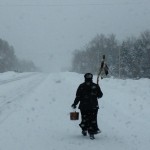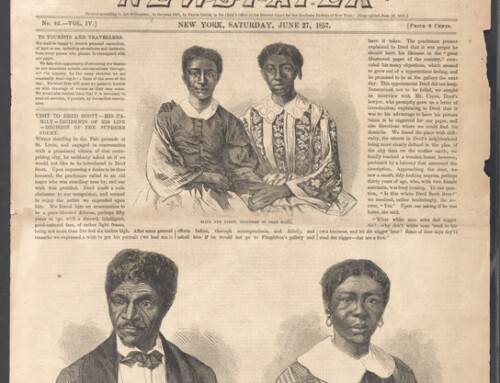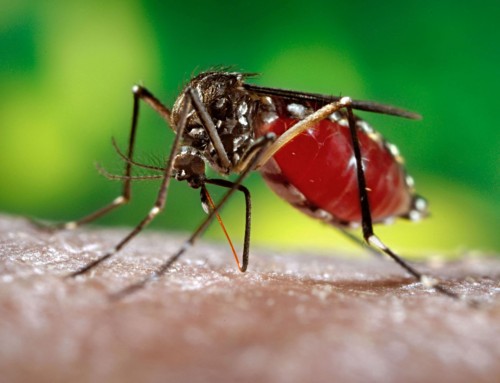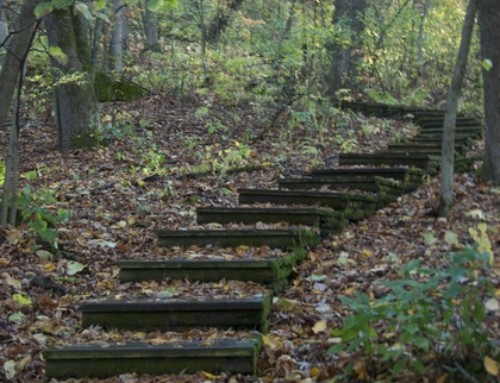When did you last think about what your life would be like without easy access to clean water? What are you willing do to for clean water?
For Sharon Day and a dedicated group of Anishaabe women, the answer is that they are willing to walk—to walk a lot—to endure the physical and financial hardships of walking hundreds of miles. They walk to raise awareness of the threats to clean water and to collect stories of our relationship with water.
For Day, it’s partly personal. She grew up at a time and in a place where she had to walk to get clean water.
“I’m 62 years old. In my childhood, we hauled the water from the well…There were three pumps. When you get up, you take your pail and go to the pump and get water for the day…When you have to carry your water, for drinking, for cooking, for bathing, that water becomes much more precious to you.”
Day’s commitment to advocating for water issues germinated from those childhood experiences; as an adult it was fed by a growing awareness of the ways in which we take water for granted.
In the 1990s, the planned expansion of Highway 55 in Minneapolis threatened Coldwater Springs, one of the last free-flowing springs in the Twin Cities. Those springs also happened to be located near areas of historical importance for the Dakota people. For Day, who lived across the river in St. Paul, the controversy awakened her desire to advocate for clean water. She protested the project and her commitment to clean water advocacy grew deeper.
Day next got involved in the Great Lakes water walks in the 2000s. In 2011 she was among the volunteers for Water Walk. Day volunteered to bring water from Gulfport, Mississippi to Bad River, Wisconsin, walking some 1,300 miles from the Gulf of Mexico to unite with volunteers carrying water from the other three cardinal direction to Lake Superior.
After feeling energized by the ceremony uniting the water from the four directions, Day and a few other walkers considered what to do next. “On my eagle feather staff, I had carved the Mississippi River because it is so important to me. I live near it; I criss-cross it many times a day; I walk my dog along the river,” Day said. The group agreed that the next walk should be along the Mississippi River.
As preparations began for the walk, plans evolved from walking part of the river in 2012 to walking its entire length in 2013. By fall 2012, Day and others were hard at work making plans, digging into the tedious but necessary tasks like fundraising, carefully planning daily routes, and recruiting volunteers. A little extra time each day on an elliptical machine also helped to prepare for the physical challenges.
On March 1, 2013 the Mississippi River Walk began when Day and a few other volunteers, including her grandson, met at the Headwaters of the Mississippi at Itasca State Park. After a water ceremony, they filled a copper pail and some jars with water from the stream. Then they walked. For the next 64 days, they walked along the shoulders of roads and highways during the day, persisting through snow and bitter cold in the first few weeks as winter refused to go away. As the days grew longer, they covered more miles, from about 24 a day to 40 by the end. Along the way, other volunteers would join them, perhaps walking a few miles, a morning, or maybe a few days.
Each morning the group started the day by making a circle in the ground using whatever materials they could find—rocks or leaves, maybe twigs—which was the focal point for the day’s offering. After walking 10-12 miles, they would take a lunch break, and use that time to talk to reporters, to check messages, and to make sure they had housing for the evening.
During the walk, they met people who shared stories of threatened water supplies, and they witnessed the way impressions of the water in the Mississippi River change along its length. At several ceremonies they drank water they collected from the Mississippi River at Itasca State Park. This wasn’t always openly welcomed.
“When we got to Cahokia, and we had a ceremony there, we brought out some fresh water from the Headwaters and we passed it around for people to drink and they were a little hesitant, because they really didn’t think it was safe.”
The reactions grew even stronger at Fort Jackson (near Venice, LA), where they had their final ceremony. “When we had that ceremony there and we passed the water around for people to drink, they were scared. They smelled it, they looked at it; they couldn’t imagine drinking the water from the Mississippi. And that was sad.”
The walkers reached Venice, Louisiana, the end of the road, on May 3rd, after walking 1500 miles. They marked the end of the walk with a water ceremony that included emptying the copper kettle into the much bigger Mississippi, refreshing the laboring river near the Gulf with a drink of clean water from its source.
That wasn’t the end, of course. Since Day got home, she has walked to the river every Sunday morning to offer a blessing. Many others who followed the Mississippi River Water Walk are doing the same thing in other places along the Mississippi.
But that’s not the end, either. Day continues to advocate for the protection of our water and to carry to others the stories she learned during the walk. We may take our water supply for granted in the big cities (we shouldn’t, but we do), but in many rural areas, folks understand the threats all too well after their ground water was contaminated by pollutants. When you’re back to hauling water in from somewhere else because the water in your well has been poisoned, you can’t help but understand the preciousness of clean water.
“What we do know from our walks and listening to people’s stories, is that there are many different people in towns and cities, smaller towns, farmers, who are concerned about the water but they’re all very disconnected. They feel like it’s only happening to them, and it’s not. It’s happening all over…One of the things we try to do with the walk is carry those stories with us.”
Day will be walking again this spring, this time along the Ohio River, through a region that has recently been impacted by its own water scares. They plan to begin on April 22nd at Pittsburgh, collecting stories and offering prayers for clean water for the 966 miles to Cairo, Illinois.
We take our water for granted. Day and the Anishaabe women walk to remind us that we shouldn’t.
So what are you willing to do for clean water?
The Ohio River Walk is scheduled to begin on April 22nd. To learn more and donate, go here.
Check out this video about last year’s Mississippi River Walk.
© Dean Klinkenberg, 2014






[…] Walking for Water […]